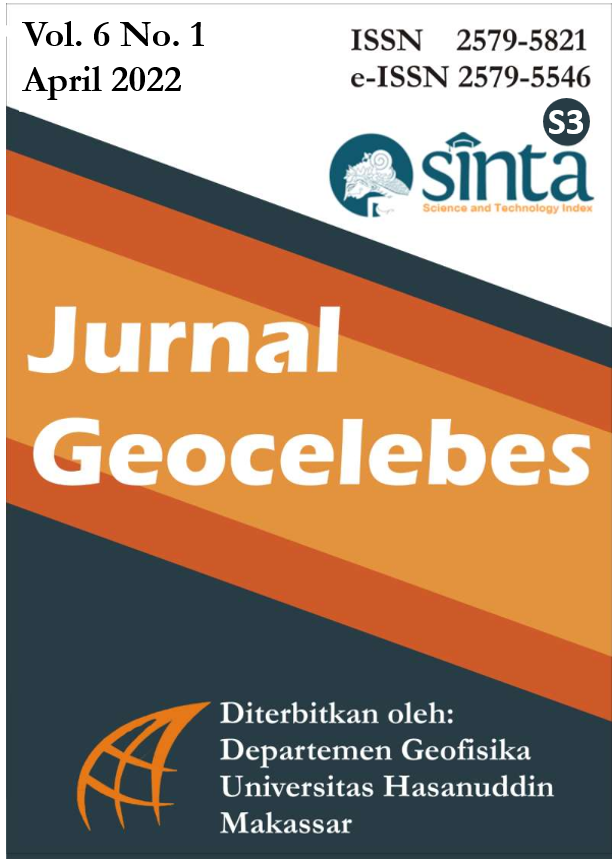Geothermal Fluid Characterisics based on Geochemical Analysis of Hot Water in The Wawolesea Area, North Konawe Regency Southeast Sulawesi Province
Karakteristik Fluida Panas Bumi Berdasarkan Analisis Geokimia Air Panas Daerah Wawolesea Kabupaten Konawe Utara Sulawesi Tenggara
DOI:
https://doi.org/10.20956/geocelebes.v6i1.19672Keywords:
geothermal, hot springs, North Konawe, ternary diagram, trilinear diagramAbstract
North Konawe Regency is an area with interesting geothermal potential to be studied. The observed geothermal potential manifestation is located in the Wawolesea area through the collection and analysis of three hot spring samples. This study aims to determine the characteristics of geothermal fluids, namely the type and origin of the fluid by conducting geochemical analysis on samples of hot springs in the study area which further shows the content of elements and chemical compounds and their respective concentrations. The analysis in this research is Inductively Coupled Plasma-Atomic Emission Spectroscopy (ICP-AES) to obtain B and Li concentrations, conductivity meter to obtain Cl concentration, visible spectroscopy method for SO4 concentration and HCO3 concentration measured by acid-base titration. The results showed that the type of hot springs in the study area was included in the Chloride type with a percentage of 81.8156%-83.3976% with a pH value of 6.7-7.4 and a hot spring temperature of 50-54°C then plotted into trilinear diagram. The Cl-Li-B Ternanry diagram shows that the source of the fluid is in a reservoir that has the same rock structure and comes from the old hydrothermal system. Based on the results of the analysis of fluid characteristics obtained from the research, it can be concluded that the hot springs of the Wawolesea Region are an indicator of the presence of geothermal sources and further research is needed on the magnitude of the geothermal potential.
References
Ansori, C. and Wardhani, F.A. 2015. Penentuan Tipe Fluida, Geotermometer Reservoir dan Hilang Panas Alamiah Berdasarkan Analisis Data Geokimia Panas Bumi Di Kabupaten Banjarnegara, Jawa Tengah. Buletin Sumber Daya Geologi. 10(3), pp. 64-77. https://doi.org/10.47599/bsdg.v10i3.148
Armstead, H.C.H. 1983. Geothermal Energy: Its Past, Present and Future Contribution to the Energy Needs of Man. London; New York: E. and F.N. Spon.
Direktorat Panas Bumi, Kementrian Energi, Ditjen EBTKE dan Pusat Sumber Daya Mineral, Batubara dan Panas Bumi Indonesia. 2017. Potensi Panas Bumi Indonesia Jilid 2. Jakarta: Direktorat Panas Bumi, Kementrian Energi dan Sumberdaya Mineral, Badan Geologi. http://distamben.kalbarprov.go.id/wp-content/uploads/2017/11/Buku-Potensi-Panas-Bumi-Indonesia-2017-Jilid-2.pdf
Fajrin, M. and Putra, A. 2021. Karakteristik Fluida Mata Air Panas di Kabupaten Tanah Datar. Jurnal Fisika Unand. 10(2), pp.212-218. https://doi.org/10.25077/jfu.10.2.212-218.2021
Giggenbach, W.F. 1991. Chemical Techniques in Geothermal Exploration (in D‘Amore, F. Applications of geochemistry in geothermal reservoir development). Rome: UNITAR/UNDP publication, pp.119-142
Nicholson, K. 1993. Geothermal Fluids. Berlin Heidelberg: Springer-Verlag.
Prasetio, R., Laksminingpuri, N., dan Satrio. 2018. Karakteristik Kimia dan Isotop Fluida Panas Bumi Daerah Gunung Tampomas, Jawa Barat. Riset Geologi dan Pertambangan. 28(1), pp. 1-11. http://dx.doi.org/10.14203/risetgeotam2018.v28.508
Putra, J.D. 2019. Pengaruh Kontrol Geologi Terhadap Sebaran Intrusi Air Laut. Studi Kasus : di Kecamatan Wawolesea Kabupaten Konawe Utara. Bachelor thesis, Universitas Halu Oleo.
Saptadji, N.M. 2009. Teknik Panas Bumi. Bandung: Departemen Teknik Perminyakan Fakultas Ilmu Kebumian dan Teknologi Mineral Institut Teknologi Bandung.
Rusmana, E., Sukido, D., Sukarna, E., Haryono. and Simandjuntak, T.O. 1993. Peta Geologi Lembar Lasusua-Kendari, Sulawesi, skala 1:250.000. Bandung: Puslitbang Geologi.
Surono, 2013. Geologi Lengan Tenggara Sulawesi. Bandung: Pusat Penelitian dan Pengembangan Geologi, Badan Geologi.
Toisuta, Y.M.K, Haryanto, A.D., Hutabarat, J., and Gentana, D. 2021. Pendugaan Temperatur Bawah Permukaan Pada Manifestasi Panas Bumi Berdasarkan Analisis Geokimia Air Panas Daerah Kecamatan Tehoru, Kabupaten Maluku Tengah, Provinsi Maluku. Padjadjaran Geoscience Journal. 5(3), pp. 268-279. http://jurnal.unpad.ac.id/geoscience/article/view/35231/16108
Utami, Z.D. and Putra, A. 2018. Penentuan Karakteristik Fluida dan Estimasi Temperatur Reservoir Panas Bumi di Sekitar Gunung Talang. Jurnal Fisika Unand. 7(2), pp.130-137. https://doi.org/10.25077/jfu.7.2.130-137.2018
Vespasiano, G., Apollaro, C., Muto, F., Dotsika, E., De Rosa, R. And Marini, L. 2014. Chemical and Isotopic Characteristics of The Warm and Cold Waters of The Luigiane Spa Near Guardia Piemontese (Calabria, Italy) in A Complex Faulted Geological Framework. Applied Geochemistry. 41, pp.73–88. https://doi.org/10.1016/j.apgeochem.2013.11.014
Downloads
Published
How to Cite
Issue
Section
License
Authors who publish with this journal agree to the following terms:
- Authors retain copyright and grant the journal right of first publication with the work simultaneously licensed under a Creative Commons Attribution License that allows others to share the work with an acknowledgement of the work's authorship and initial publication in this journal.
- Authors are able to enter into separate, additional contractual arrangements for the non-exclusive distribution of the journal's published version of the work (e.g., post it to an institutional repository or publish it in a book), with an acknowledgement of its initial publication in this journal.
- Authors are permitted and encouraged to post their work online (e.g., in institutional repositories or on their website) prior to and during the submission process, as it can lead to productive exchanges, as well as earlier and greater citation of published work (See The Effect of Open Access).





